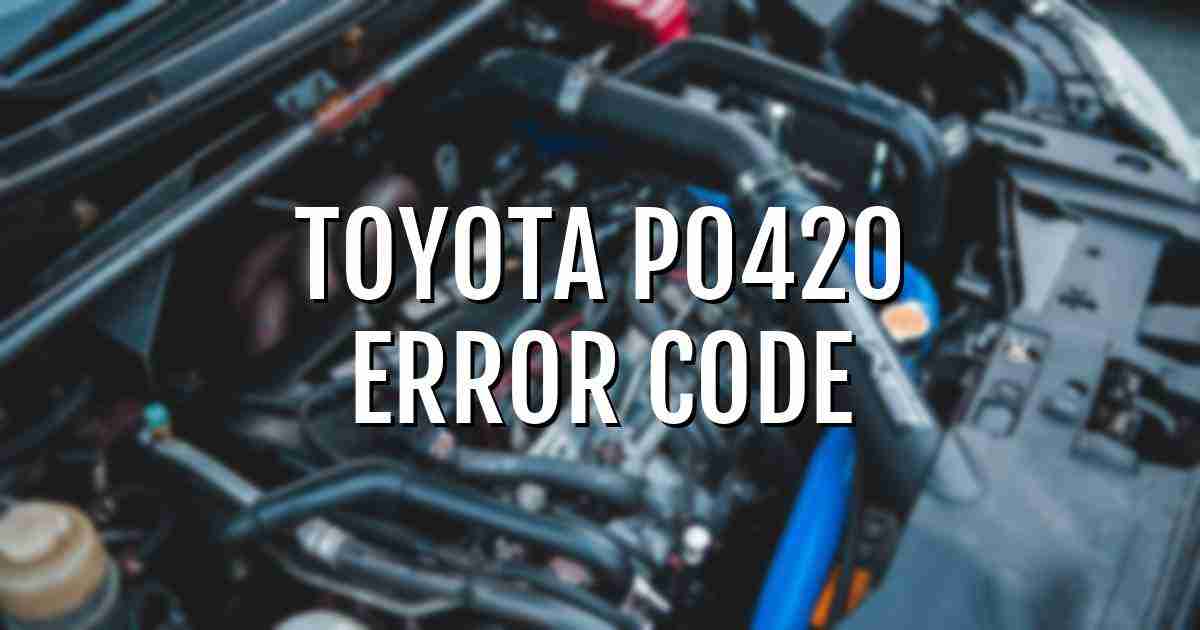The OBD code P0420 for Toyota indicates a Catalyst System Efficiency Below Threshold (Bank 1).
This affects the catalytic converter and related sensors.
Symptoms include the Check Engine Light being illuminated.
Causes can include a faulty catalytic converter, oxygen sensors, or fuel injectors.
While not an immediate threat, it can affect emissions.
A possible fix involves inspecting and repairing/replacing the affected components and wiring harness/connectors.
| Repair Importance Level | 6.67 (Out of 10) |
| Estimated Repair Time | Approximately 1.0 hour |
| Repair Difficulty Level | 6.67 (Out of 10) |
Symptoms of the Toyota p0420 OBD Code
The vehicle may experience decreased fuel efficiency and the check engine light may illuminate.
- Symptoms: Check Engine Light ON.
- Decreased fuel efficiency.
- Loss of engine power.
- Increased exhaust emissions.
- rattling noise from the exhaust system.
Do you know you can clear most fault codes—but some could mean serious danger? Don’t take chances with your safety or your family’s safety. This budget-friendly car scanner makes it easy to clear fault codes in seconds while showing you exactly what’s wrong. Plug it in, connect to your Android or iOS phone, and instantly check live data. You’ll know if it’s a minor issue you can clear or something serious that needs attention—so you can drive safely and stress-free. (Today’s Deal)
Causes of the Toyota p0420 OBD Code
Issues with the catalytic converter or oxygen sensors can trigger fault code P0420 in Toyota vehicles.
- P0420 can be caused by a gas leak from the exhaust system.
- A faulty Threeway Catalyst Converter Bank 1.
- A faulty Air Fuel Ratio (A/F) Sensor Bank 1 (Sensor 1 or Front Sensor or Upstream Sensor).
- A faulty Heated Oxygen Sensor Bank 1 (Sensor 2 or Rear Sensor or Downstream Sensor).
- Or faulty fuel injector(s).
Fixing Toyota Error Code p0420 Step By Step
Addressing a faulty catalytic converter or oxygen sensor can resolve Toyota P0420 code issues.
- To fix Toyota OBDII code P0420, start by reviewing the ‘Possible Causes’ mentioned above and visually examining the corresponding wiring harness and connectors.
- Check for any damaged components and inspect the connector pins for signs of being broken, bent, pushed out, or corroded.
- Next, perform a thorough inspection of the catalytic converter to ensure it is functioning correctly and not clogged or damaged.
- If the catalytic converter is faulty, replace it with a new one.
- Finally, reset the vehicle’s ECU by disconnecting the battery for a few minutes or using a scan tool to clear the fault code.
Cost Of Fixing Toyota p0420 Fault Code
The repair for Toyota P0420 may involve replacing the catalytic converter due to efficiency below threshold.
The cost to diagnose and fix a Toyota OBD code P0420 typically ranges from $75 to $150 per hour for labor rates.
With an estimated repair time of 1. 0 hour, the total cost can be around $75 to $150, depending on shop rates and the complexity of the issue.
That fault code is a turning point. If repair costs are climbing and your current loan feels like it’s holding you back, this is the time to plan ahead. The free Car Loan Payment Tracker helps you see how quickly you can pay off what’s left—and start preparing, with confidence, for your dream car.
Details of the Toyota p0420 OBD Code
Code P0420 in a Toyota indicates a catalyst system efficiency below threshold in bank 1.
OBD code P0420 for Toyota vehicles indicates a catalyst system efficiency below threshold in bank 1. This means that the catalytic converter is not performing as expected in reducing emissions.
The ECM triggers this code by comparing the signals from the upstream and downstream oxygen sensors.
If the downstream sensor shows a similar pattern to the upstream sensor, it suggests the catalytic converter is not working efficiently.
Mechanic’s Tech Notes
Detailed information on diagnosing and repairing Toyota P0420 code related to catalytic converter efficiency below threshold.
To diagnose and fix OBDII code P0420 in a Toyota, start by checking the oxygen sensors’ data with a scan tool.
Use a voltmeter to test the oxygen sensor’s heater circuit for proper voltage.
Inspect the exhaust system for leaks or damage that could affect sensor readings.
Check the catalytic converter for efficiency using a scan tool capable of monitoring live data.
If the converter is failing, replacement is necessary.
Additionally, ensure there are no vacuum leaks affecting sensor readings.
Regular maintenance like spark plug replacement can also help prevent this code.
FAQ
Common causes of OBD code P0420 in a Toyota: Faulty Threeway Catalyst Converter Bank 1, Faulty A/F Sensor Bank 1, Faulty Oxygen Sensor Bank 1. Check wiring and connectors.
Diagnose P0420 in Toyota: Check for gas leaks, faulty catalyst converter, A/F sensor, O2 sensor, or fuel injectors. Inspect wiring and connectors for damage.
No, it is not necessary to replace the catalytic converter immediately. First, diagnose and address the specific causes listed to resolve the P0420 code in the Toyota vehicle.

Wrap Up
If your Toyota triggers OBDII code P0420, you may notice decreased fuel efficiency, a rough idle, or a lack of power.
This code typically indicates a failing catalytic converter, faulty oxygen sensors, or exhaust leaks.
To address Toyota OBDII code P0420, start by inspecting the oxygen sensors and their wiring for damage or corrosion.
Check for exhaust leaks and ensure the catalytic converter is functioning correctly.
If necessary, replace the oxygen sensors or catalytic converter to resolve the issue.

